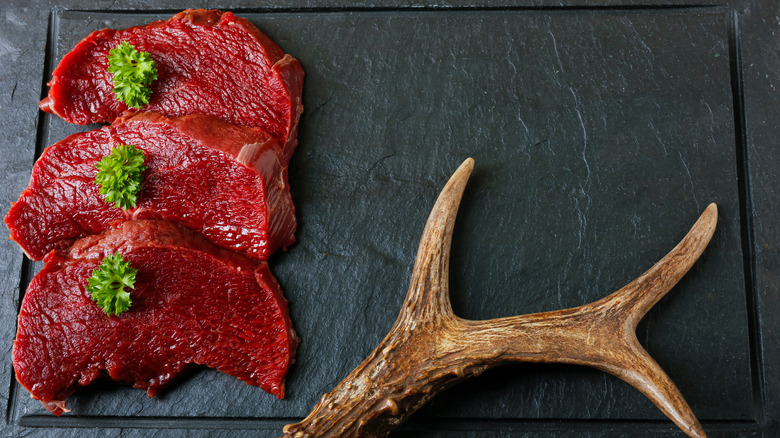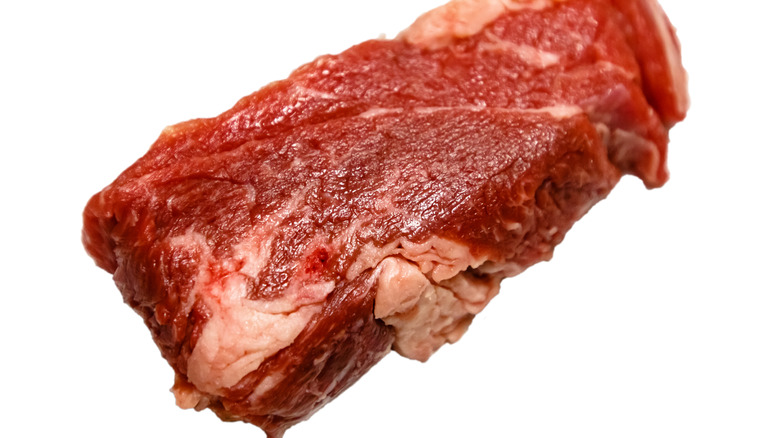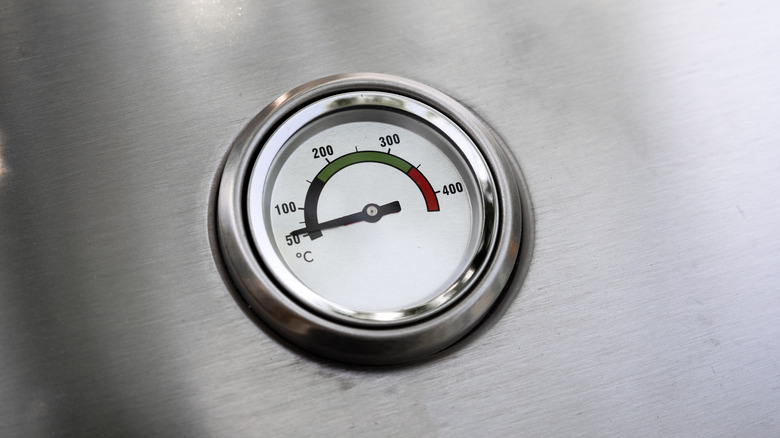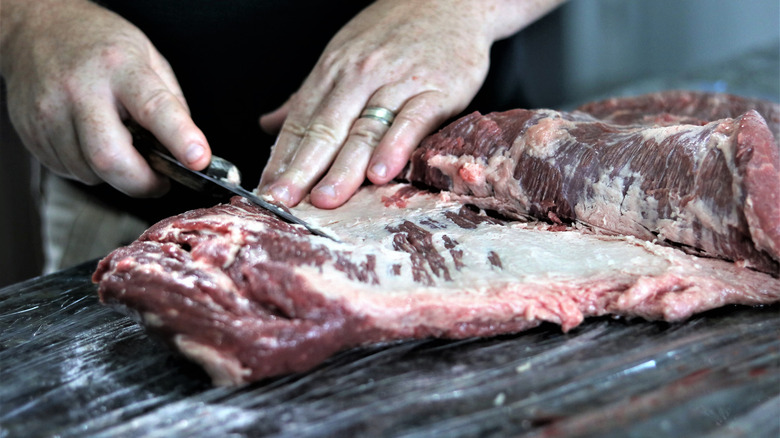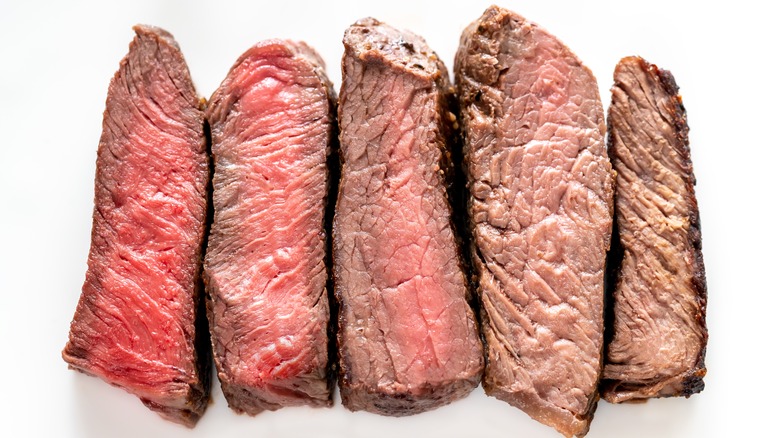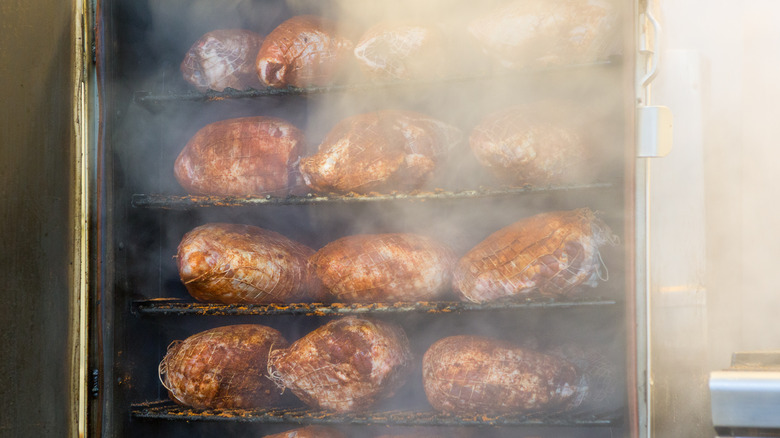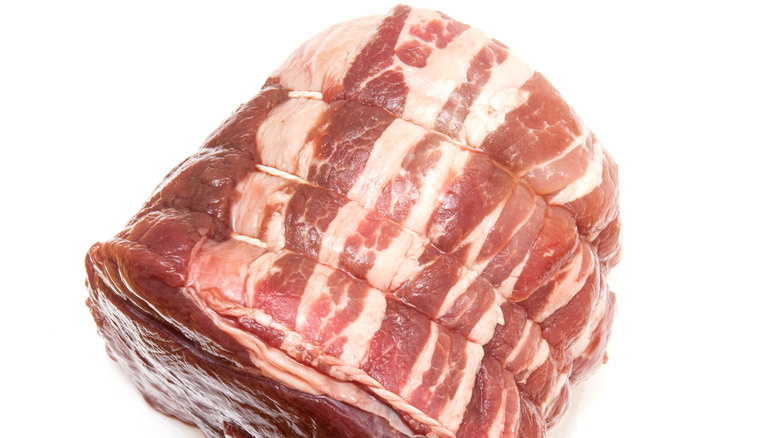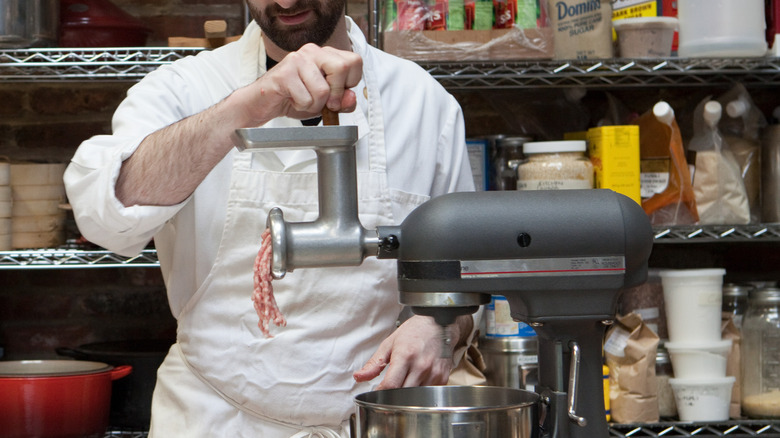7 Mistakes You're Making When Cooking Venison
For those who do so, hunting and eating game is often as much tradition as it is anything else. Knowledge of tracking and harvesting an animal is frequently generational, handed down over time. Unfortunately, so is cooking the game. As knowledge transfers, new bits of wisdom get added, and other parts deemed unnecessary or irrelevant get tossed to the wayside. This game of telephone leaves the most convenient ways to cook venison — truncated repeatedly across generations — but possibly not the best methods. They certainly get the job done, but not in the best culinarily-correct manner, and the results suffer.
David Bancroft is an avid deer hunter who thrives on the activity. He's also the chef and owner of Acre and Bow & Arrow restaurants in Auburn, Alabama. After he harvests a deer, he stops acting like a hunter and approaches the rest of the process as a chef. He's lent his knowledge and expertise in explaining every cuts of venison; now, he's helping us understand the mistakes most people make when cooking or preparing to cook deer or elk meat. Just by way of explanation, "venison" can apply to either. Although not the same species, they share similar body composition and musculature in varying degrees of size.
You expect it to be the same as other red meat
Venison is red meat, and all red meat is the same, right? Nothing could be farther from the truth. For the easiest example, we'll compare the lives of cattle and deer. Cattle spend most of their lives, well, the part before they get sent to the feedlot, anyway, slowly wandering and grazing, often in open fields. In contrast, deer are built for speed and agility to escape their many predators and don't have the meandering downtime that cattle do. As such, they build muscles and fat in different ways. "A deer's shoulder is built for jumping, running, and leaping," Bancroft explains, contrasting it with a beef chuck.
Because of the lack of fat and marbling in venison cuts, you should never substitute beef for a cut of venison. We'll look deeper into how to treat venison further down, but for now, suffice it to say that when grilling, roasting, or pan-roasting venison, high heat and quick cooking are essential to prevent overcooking and drying this ultra-lean meat out. With the higher degree of marbling and overall fat, you can choose degrees of doneness when cooking beef. With venison, if you want the best possible representation, you'd better like your meat rare to medium rare. Stewing and braising give you more latitude, cooking the meat until fall-apart tender, but even then, it behaves differently due to the lack of fat.
Don't cook it at too low of a temperature
Speaking solely in the context of cuts that you'll be cooking using dry-heat methods, Bancroft warns that low cooking temperatures are the enemy of venison. If you're using neck meat or shanks for a stew or pot roast, this does not apply. To best illustrate this, let's look at cooking something fatty and lean. For our fatty example, we'll use a skin-on chicken breast. To get the skin crisp, you wouldn't just throw it in a scorching-hot pan and hope for the best. You'd want to start at medium-high heat and allow the fat beneath the skin to render over time, leaving you with perfectly browned skin crisp enough to strike a match on. For our lean example, let's choose a center-cut fillet mignon. If you start that piece of beef at the same medium-high temperature as the chicken breast, you will begin to extract moisture from the meat before it has an opportunity to undergo Maillard browning. Moisture prevents that browning because the heat energy gets spent in evaporating the water instead of caramelizing the proteins.
Now substitute the fillet for a piece of venison round; they're approximately the same when considering fat content, so there's no reason you'd want to render fat from the venison. So, to create and enhance the Maillard reaction, you need high heat that will start to work on the exterior of the piece of meat before moisture begins to leach from the interior.
Remove the fat
Speaking from a chef's perspective, one that tries to provide the best product to the most customers, Bancroft is pretty firm on his stance about venison fat. For those who won't eat venison or are afraid to try it for fear of "gaminess," he recommends removing the fat from the venison. "All the gaminess is in the fat," he explains. It's not that venison contains much fat in the first place, but what fat there is packs a very pronounced flavor and residual mouthfeel that some find off-putting.
For a quick explanation, venison fat has a high content of stearic acid, also found in lamb fat, which folks consider gamey, too. The stearic acid also tends to coat the mouth with a bit of a waxy texture, as exemplified in another product high in it; chocolate. Venison fat also has a high melting point, not rendering until it reaches 120 degrees Fahrenheit, which is rapidly approaching rare in terms of meat doneness. Chef and author Hank Shaw explains the temperature issue along with some ways to mitigate the gaminess while utilizing some of the fat as part of consuming as much of the animal as possible, but for those not wanting to put in that extra work or are just averse to the gamey flavor, trimming the fat is the safest bet.
You overcook it
The deer didn't have much fat on it, to begin with, and what it did have, you've trimmed away to avoid the gamey flavor. Neck, shanks, and shoulder aside, you have extremely lean meat that will dry out from the lack of fat if you cook it beyond medium rare, which is 135 degrees Fahrenheit. Bancroft doesn't flinch from this idea. If you're dealing with thinly cut pieces — scallopine, cutlet, whatever you choose to call it, this calls for a quick trip through a very hot pan, enough to sear the outside and quickly raise the internal temperature to be rare or medium rare. A roast, from the top or bottom round, for example, should use the same treatment in the oven or on the grill. High heat for a short time is the best means of treating it.
For burgers, if you follow our ground meat advice below, you'll have a little more forgiving meat to work with. The added fat will help retain moisture, and you can get a good sear before moving them to lower temperatures to finish cooking, but if you prefer your burgers cooked to medium or higher, venison might not be the best meat choice for you.
Control the moisture when smoking it
If there's anything we've learned thus far about venison, it's lean. Lean meat dries faster than fatty meat, so you must take steps to mitigate that when putting it on the smoker. Let's clarify one thing before we move on; you will not be able to achieve the falling-apart, BBQ-like textures one would expect from a beef brisket or pork butt with any cut other than the neck. There is simply not enough fat or connective tissue in venison to stand up to long smokes in other cuts.
So, whether smoking a backstrap, tenderloin, or round, you should take care when smoking venison. First, you can brine it. Wet drying or dry brining are each perfectly sound methods to help retain moisture and impart flavor. Second, smoking preserves food because it extracts water from the food, removing the medium for pathogens to migrate through the food. Essentially, smoking dries your food. Controlling the ambient humidity inside the smoker goes a long way in preventing moisture loss, and something as simple as placing a water pan in the smoker takes care of that issue. The final thing to remember is, as Bancroft previously warned, don't cook your venison, even on a smoker, beyond medium rare (135 degrees Fahrenheit).
Don't wrap it in bacon
Since venison has little intramuscular fat and even less marbling, it's prone to drying when cooked incorrectly. Logic would dictate that adding fat to your venison would make it moister by default. That concept is true to an extent. If you want to add moisture to the meat via adding fat, the most surefire way to accomplish this is by "larding" the meat with beef suet or pork fatback. Barding involves cutting strips of fat to the size and shape of a special needle, then using the needle to thread the fat through the meat, leaving spikes of fat wherever it's passed. As the meat cooks, the internal fat renders, and the meat takes on that fat which moistens it.
The more popular way is to wrap it in fat, bacon, more often than not, because bacon is an easily available product that should add smokey sweetness to the meat on top of the added moisture. But the bacon fat cannot penetrate the meat using this method, and at best, bastes the meat in the rendered fat. Bancroft is adamantly opposed to this method. Direct heat never touches the exterior of the venison in this method, and the moisture from the bacon further inhibits any Maillard browning. "What happens is, the bacon on the outside cooks, but the venison inside just steams, making it gray and dry," he explains. High heat is your best moisture retainer when cooking this lean meat.
Grind it right
When you've cleaned and trimmed all the other cuts and possibly thrown the shoulder onto the scrap pile, it's time to consider grinding. Whether your goal is burger meat or sausage, the way you grind it has a huge impact on your end product. As we discussed, the venison fat could be a no-go for you, so you'd trim it out in that case. But grinding nothing but lean meat results in pasty, dry ground meat, according to Bancroft. You'll never find ground filet mignon in your butcher's case for the same reason; it's terrible.
Your best bet for ground meat is to weigh the meat you're about to grind and add ¼ of that weight of pork fatback or beef suet to the grind, then mix it all to incorporate it. This action will yield an 80/20 blend of lean to fat, much as you'd find in supermarket ground beef. That ratio will be higher in fat if you're making sausage, ideally 60/40. The 80/20 mix will give you burgers, meatloaf, or taco meat with the moisture of ground beef but won't diminish the venison flavor significantly. The other big mistake people make in this area is grinding too much silver skin with the meat. The structures of the silver skin and the meat are quite different, and an excess of the former will prevent your meat from binding together when trying to patty it for burgers, leaving you with crumbly venison.
